Domestic Violence: Analysis and Human Rights
VerifiedAdded on 2023/01/11
|13
|3490
|91
AI Summary
This essay provides a detailed analysis of domestic violence in Australia, including key features, human needs, and relevant human rights. It also discusses Australian and international laws related to domestic violence.
Contribute Materials
Your contribution can guide someone’s learning journey. Share your
documents today.
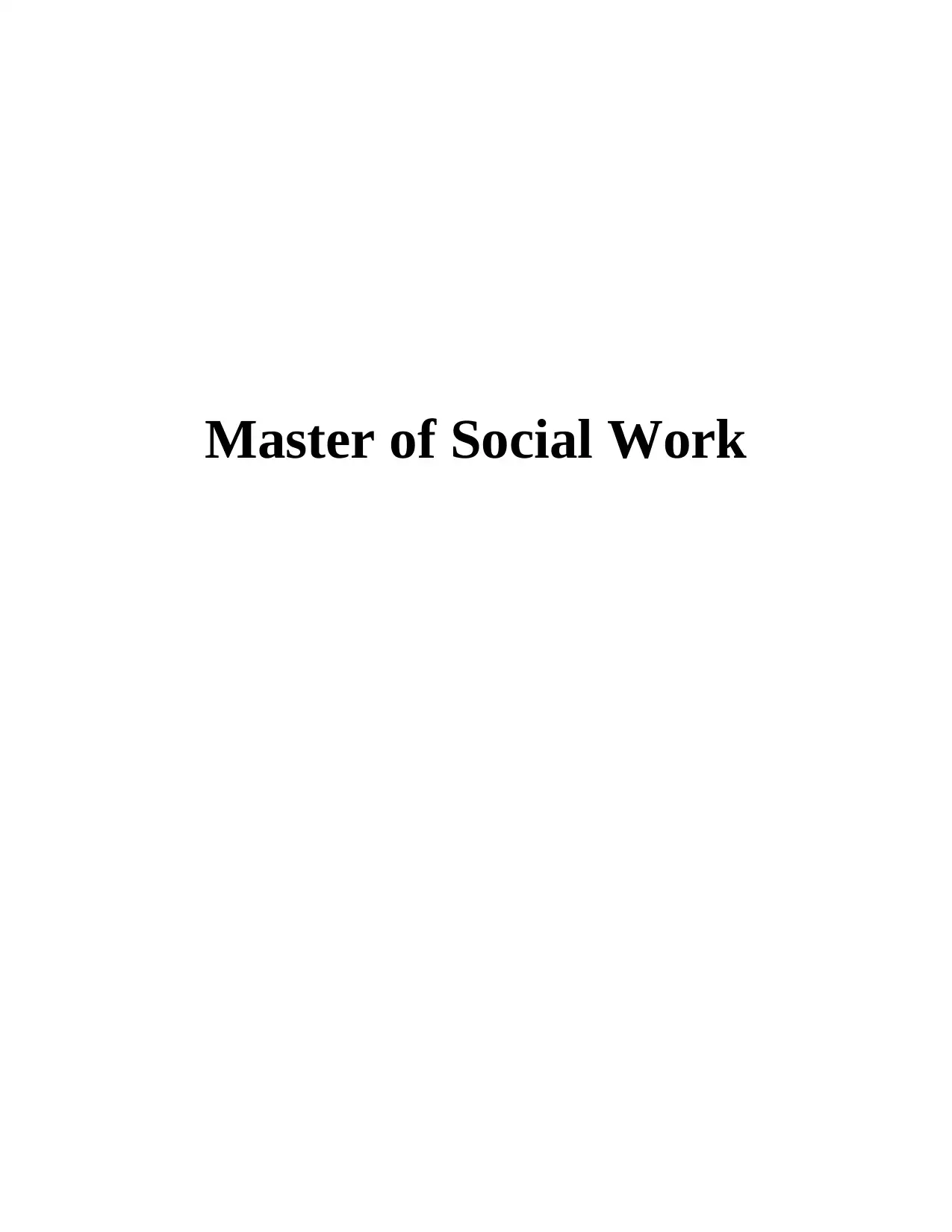
Master of Social Work
Secure Best Marks with AI Grader
Need help grading? Try our AI Grader for instant feedback on your assignments.
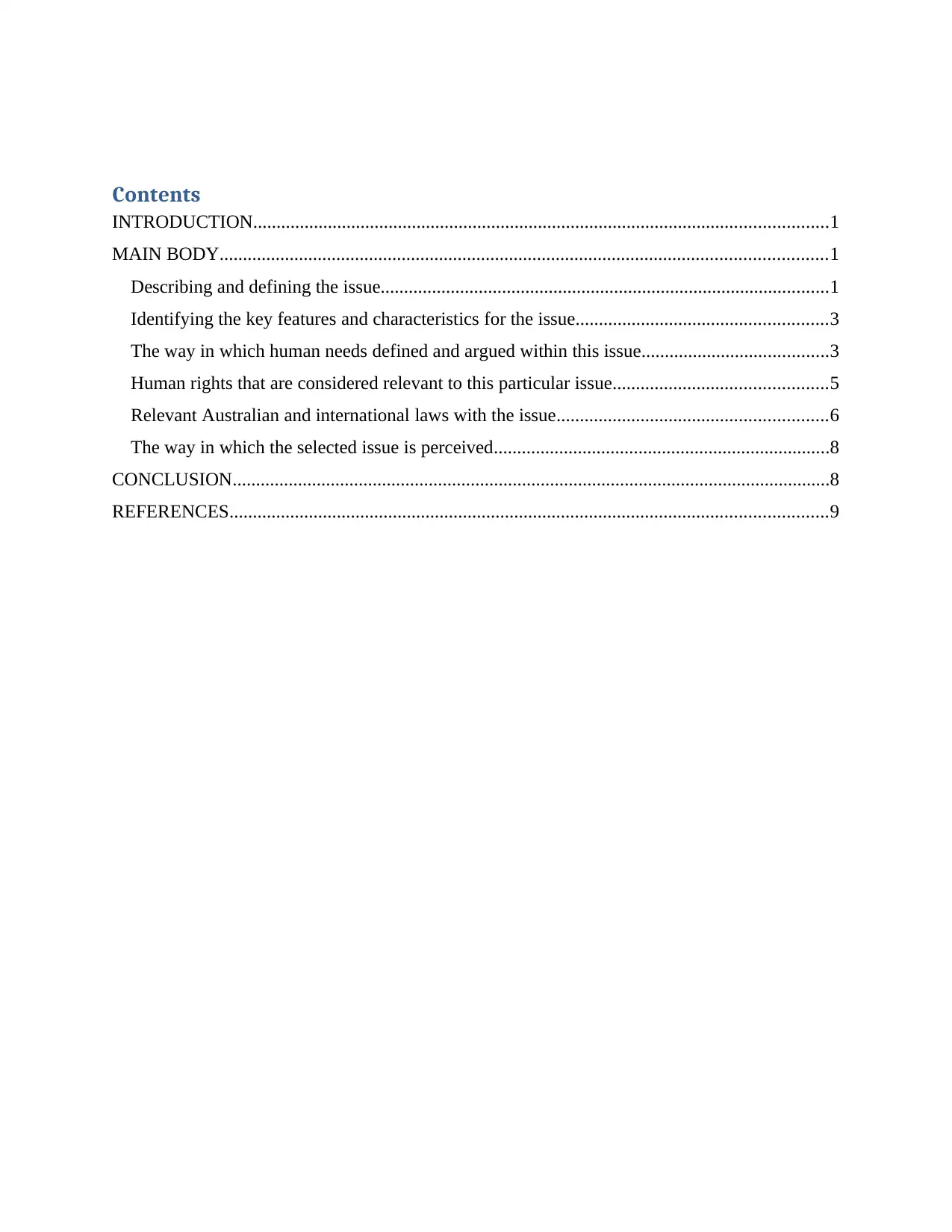
Contents
INTRODUCTION...........................................................................................................................1
MAIN BODY..................................................................................................................................1
Describing and defining the issue................................................................................................1
Identifying the key features and characteristics for the issue......................................................3
The way in which human needs defined and argued within this issue........................................3
Human rights that are considered relevant to this particular issue..............................................5
Relevant Australian and international laws with the issue..........................................................6
The way in which the selected issue is perceived........................................................................8
CONCLUSION................................................................................................................................8
REFERENCES................................................................................................................................9
INTRODUCTION...........................................................................................................................1
MAIN BODY..................................................................................................................................1
Describing and defining the issue................................................................................................1
Identifying the key features and characteristics for the issue......................................................3
The way in which human needs defined and argued within this issue........................................3
Human rights that are considered relevant to this particular issue..............................................5
Relevant Australian and international laws with the issue..........................................................6
The way in which the selected issue is perceived........................................................................8
CONCLUSION................................................................................................................................8
REFERENCES................................................................................................................................9

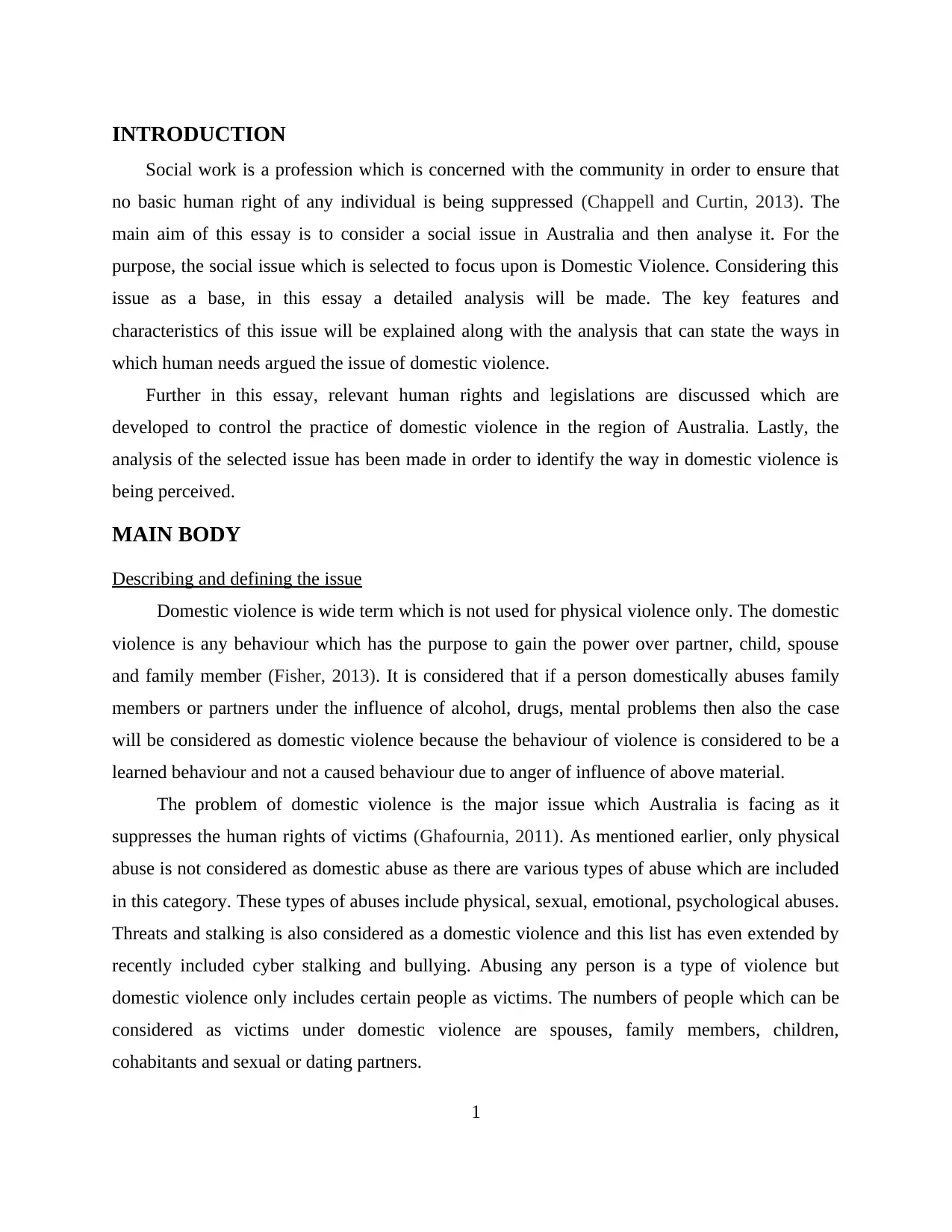
INTRODUCTION
Social work is a profession which is concerned with the community in order to ensure that
no basic human right of any individual is being suppressed (Chappell and Curtin, 2013). The
main aim of this essay is to consider a social issue in Australia and then analyse it. For the
purpose, the social issue which is selected to focus upon is Domestic Violence. Considering this
issue as a base, in this essay a detailed analysis will be made. The key features and
characteristics of this issue will be explained along with the analysis that can state the ways in
which human needs argued the issue of domestic violence.
Further in this essay, relevant human rights and legislations are discussed which are
developed to control the practice of domestic violence in the region of Australia. Lastly, the
analysis of the selected issue has been made in order to identify the way in domestic violence is
being perceived.
MAIN BODY
Describing and defining the issue
Domestic violence is wide term which is not used for physical violence only. The domestic
violence is any behaviour which has the purpose to gain the power over partner, child, spouse
and family member (Fisher, 2013). It is considered that if a person domestically abuses family
members or partners under the influence of alcohol, drugs, mental problems then also the case
will be considered as domestic violence because the behaviour of violence is considered to be a
learned behaviour and not a caused behaviour due to anger of influence of above material.
The problem of domestic violence is the major issue which Australia is facing as it
suppresses the human rights of victims (Ghafournia, 2011). As mentioned earlier, only physical
abuse is not considered as domestic abuse as there are various types of abuse which are included
in this category. These types of abuses include physical, sexual, emotional, psychological abuses.
Threats and stalking is also considered as a domestic violence and this list has even extended by
recently included cyber stalking and bullying. Abusing any person is a type of violence but
domestic violence only includes certain people as victims. The numbers of people which can be
considered as victims under domestic violence are spouses, family members, children,
cohabitants and sexual or dating partners.
1
Social work is a profession which is concerned with the community in order to ensure that
no basic human right of any individual is being suppressed (Chappell and Curtin, 2013). The
main aim of this essay is to consider a social issue in Australia and then analyse it. For the
purpose, the social issue which is selected to focus upon is Domestic Violence. Considering this
issue as a base, in this essay a detailed analysis will be made. The key features and
characteristics of this issue will be explained along with the analysis that can state the ways in
which human needs argued the issue of domestic violence.
Further in this essay, relevant human rights and legislations are discussed which are
developed to control the practice of domestic violence in the region of Australia. Lastly, the
analysis of the selected issue has been made in order to identify the way in domestic violence is
being perceived.
MAIN BODY
Describing and defining the issue
Domestic violence is wide term which is not used for physical violence only. The domestic
violence is any behaviour which has the purpose to gain the power over partner, child, spouse
and family member (Fisher, 2013). It is considered that if a person domestically abuses family
members or partners under the influence of alcohol, drugs, mental problems then also the case
will be considered as domestic violence because the behaviour of violence is considered to be a
learned behaviour and not a caused behaviour due to anger of influence of above material.
The problem of domestic violence is the major issue which Australia is facing as it
suppresses the human rights of victims (Ghafournia, 2011). As mentioned earlier, only physical
abuse is not considered as domestic abuse as there are various types of abuse which are included
in this category. These types of abuses include physical, sexual, emotional, psychological abuses.
Threats and stalking is also considered as a domestic violence and this list has even extended by
recently included cyber stalking and bullying. Abusing any person is a type of violence but
domestic violence only includes certain people as victims. The numbers of people which can be
considered as victims under domestic violence are spouses, family members, children,
cohabitants and sexual or dating partners.
1
Secure Best Marks with AI Grader
Need help grading? Try our AI Grader for instant feedback on your assignments.
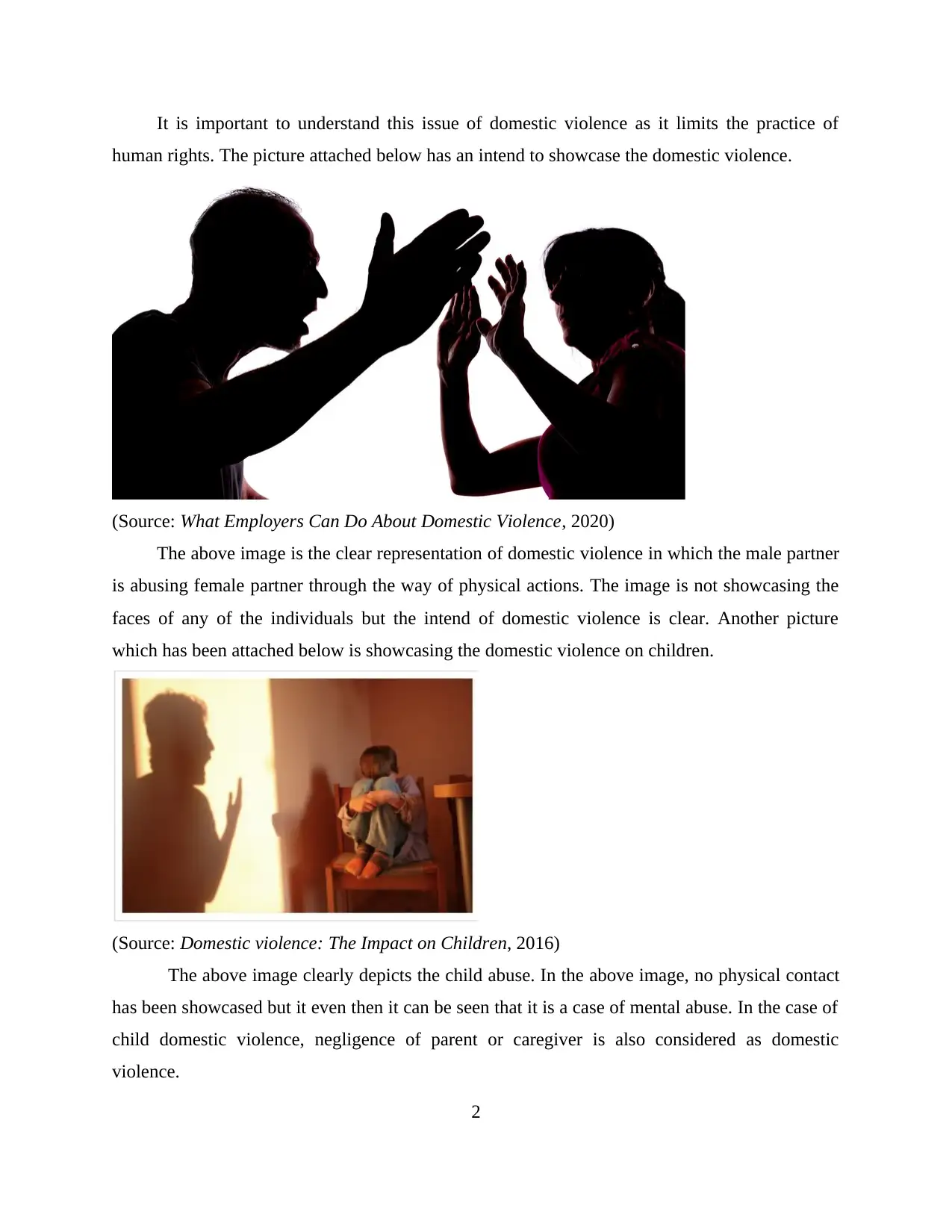
It is important to understand this issue of domestic violence as it limits the practice of
human rights. The picture attached below has an intend to showcase the domestic violence.
(Source: What Employers Can Do About Domestic Violence, 2020)
The above image is the clear representation of domestic violence in which the male partner
is abusing female partner through the way of physical actions. The image is not showcasing the
faces of any of the individuals but the intend of domestic violence is clear. Another picture
which has been attached below is showcasing the domestic violence on children.
(Source: Domestic violence: The Impact on Children, 2016)
The above image clearly depicts the child abuse. In the above image, no physical contact
has been showcased but it even then it can be seen that it is a case of mental abuse. In the case of
child domestic violence, negligence of parent or caregiver is also considered as domestic
violence.
2
human rights. The picture attached below has an intend to showcase the domestic violence.
(Source: What Employers Can Do About Domestic Violence, 2020)
The above image is the clear representation of domestic violence in which the male partner
is abusing female partner through the way of physical actions. The image is not showcasing the
faces of any of the individuals but the intend of domestic violence is clear. Another picture
which has been attached below is showcasing the domestic violence on children.
(Source: Domestic violence: The Impact on Children, 2016)
The above image clearly depicts the child abuse. In the above image, no physical contact
has been showcased but it even then it can be seen that it is a case of mental abuse. In the case of
child domestic violence, negligence of parent or caregiver is also considered as domestic
violence.
2
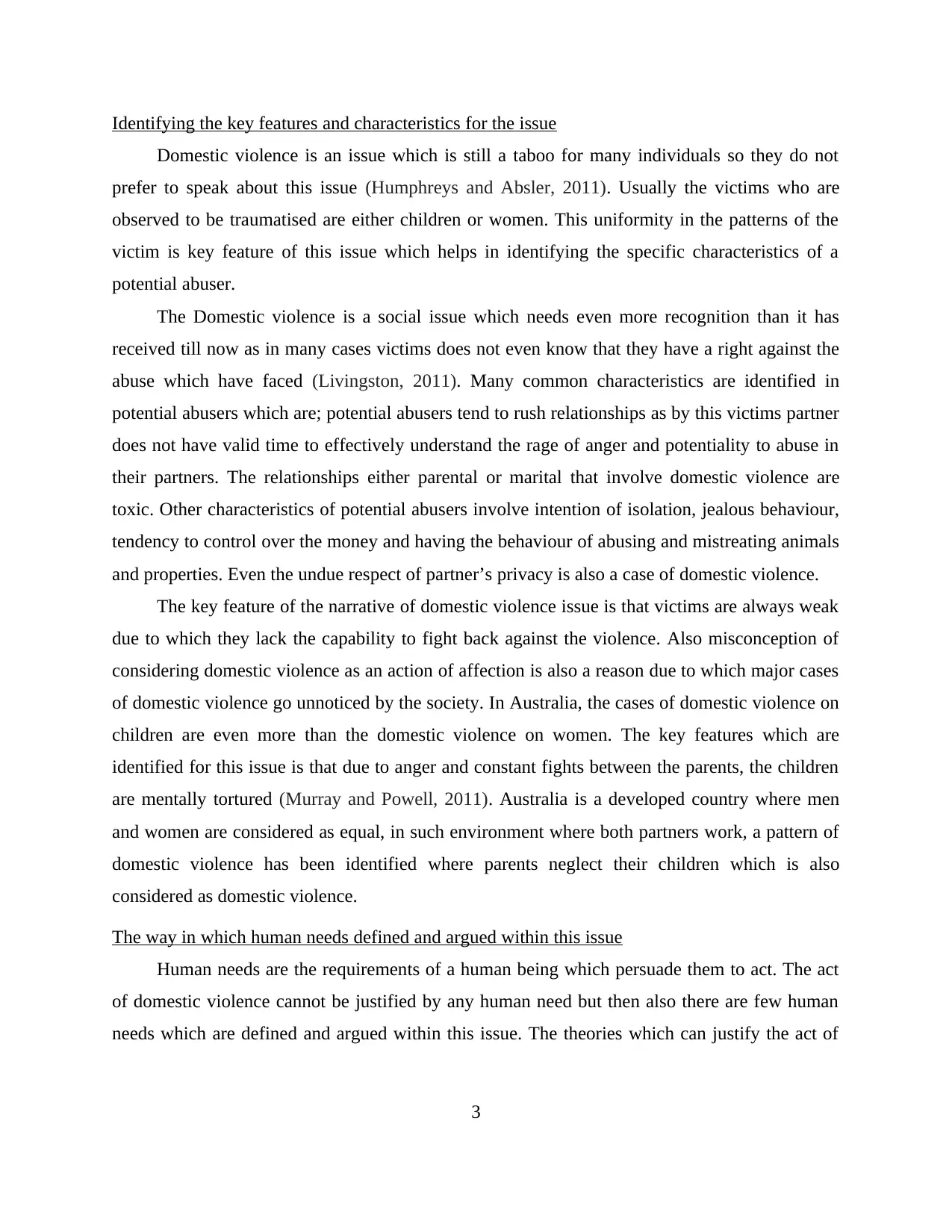
Identifying the key features and characteristics for the issue
Domestic violence is an issue which is still a taboo for many individuals so they do not
prefer to speak about this issue (Humphreys and Absler, 2011). Usually the victims who are
observed to be traumatised are either children or women. This uniformity in the patterns of the
victim is key feature of this issue which helps in identifying the specific characteristics of a
potential abuser.
The Domestic violence is a social issue which needs even more recognition than it has
received till now as in many cases victims does not even know that they have a right against the
abuse which have faced (Livingston, 2011). Many common characteristics are identified in
potential abusers which are; potential abusers tend to rush relationships as by this victims partner
does not have valid time to effectively understand the rage of anger and potentiality to abuse in
their partners. The relationships either parental or marital that involve domestic violence are
toxic. Other characteristics of potential abusers involve intention of isolation, jealous behaviour,
tendency to control over the money and having the behaviour of abusing and mistreating animals
and properties. Even the undue respect of partner’s privacy is also a case of domestic violence.
The key feature of the narrative of domestic violence issue is that victims are always weak
due to which they lack the capability to fight back against the violence. Also misconception of
considering domestic violence as an action of affection is also a reason due to which major cases
of domestic violence go unnoticed by the society. In Australia, the cases of domestic violence on
children are even more than the domestic violence on women. The key features which are
identified for this issue is that due to anger and constant fights between the parents, the children
are mentally tortured (Murray and Powell, 2011). Australia is a developed country where men
and women are considered as equal, in such environment where both partners work, a pattern of
domestic violence has been identified where parents neglect their children which is also
considered as domestic violence.
The way in which human needs defined and argued within this issue
Human needs are the requirements of a human being which persuade them to act. The act
of domestic violence cannot be justified by any human need but then also there are few human
needs which are defined and argued within this issue. The theories which can justify the act of
3
Domestic violence is an issue which is still a taboo for many individuals so they do not
prefer to speak about this issue (Humphreys and Absler, 2011). Usually the victims who are
observed to be traumatised are either children or women. This uniformity in the patterns of the
victim is key feature of this issue which helps in identifying the specific characteristics of a
potential abuser.
The Domestic violence is a social issue which needs even more recognition than it has
received till now as in many cases victims does not even know that they have a right against the
abuse which have faced (Livingston, 2011). Many common characteristics are identified in
potential abusers which are; potential abusers tend to rush relationships as by this victims partner
does not have valid time to effectively understand the rage of anger and potentiality to abuse in
their partners. The relationships either parental or marital that involve domestic violence are
toxic. Other characteristics of potential abusers involve intention of isolation, jealous behaviour,
tendency to control over the money and having the behaviour of abusing and mistreating animals
and properties. Even the undue respect of partner’s privacy is also a case of domestic violence.
The key feature of the narrative of domestic violence issue is that victims are always weak
due to which they lack the capability to fight back against the violence. Also misconception of
considering domestic violence as an action of affection is also a reason due to which major cases
of domestic violence go unnoticed by the society. In Australia, the cases of domestic violence on
children are even more than the domestic violence on women. The key features which are
identified for this issue is that due to anger and constant fights between the parents, the children
are mentally tortured (Murray and Powell, 2011). Australia is a developed country where men
and women are considered as equal, in such environment where both partners work, a pattern of
domestic violence has been identified where parents neglect their children which is also
considered as domestic violence.
The way in which human needs defined and argued within this issue
Human needs are the requirements of a human being which persuade them to act. The act
of domestic violence cannot be justified by any human need but then also there are few human
needs which are defined and argued within this issue. The theories which can justify the act of
3
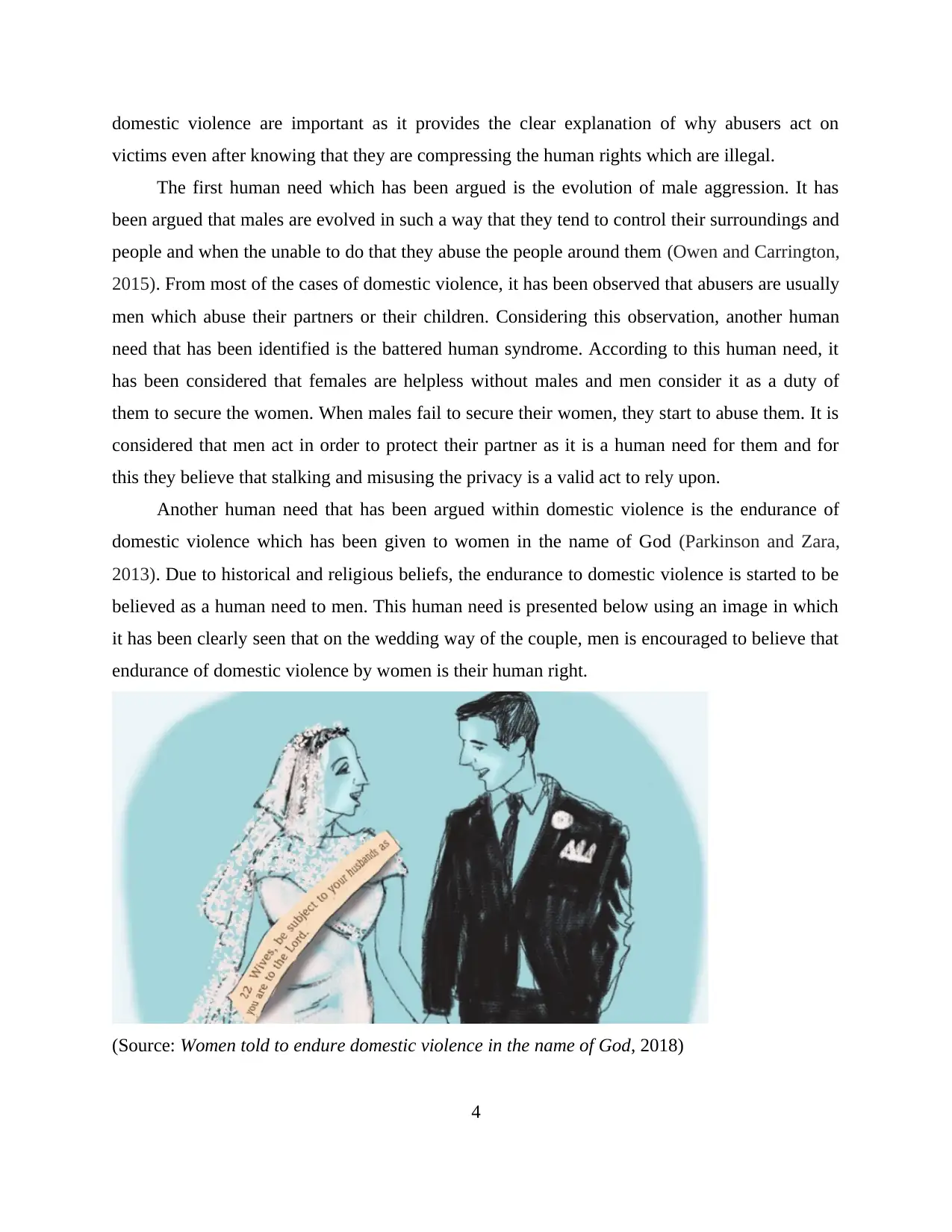
domestic violence are important as it provides the clear explanation of why abusers act on
victims even after knowing that they are compressing the human rights which are illegal.
The first human need which has been argued is the evolution of male aggression. It has
been argued that males are evolved in such a way that they tend to control their surroundings and
people and when the unable to do that they abuse the people around them (Owen and Carrington,
2015). From most of the cases of domestic violence, it has been observed that abusers are usually
men which abuse their partners or their children. Considering this observation, another human
need that has been identified is the battered human syndrome. According to this human need, it
has been considered that females are helpless without males and men consider it as a duty of
them to secure the women. When males fail to secure their women, they start to abuse them. It is
considered that men act in order to protect their partner as it is a human need for them and for
this they believe that stalking and misusing the privacy is a valid act to rely upon.
Another human need that has been argued within domestic violence is the endurance of
domestic violence which has been given to women in the name of God (Parkinson and Zara,
2013). Due to historical and religious beliefs, the endurance to domestic violence is started to be
believed as a human need to men. This human need is presented below using an image in which
it has been clearly seen that on the wedding way of the couple, men is encouraged to believe that
endurance of domestic violence by women is their human right.
(Source: Women told to endure domestic violence in the name of God, 2018)
4
victims even after knowing that they are compressing the human rights which are illegal.
The first human need which has been argued is the evolution of male aggression. It has
been argued that males are evolved in such a way that they tend to control their surroundings and
people and when the unable to do that they abuse the people around them (Owen and Carrington,
2015). From most of the cases of domestic violence, it has been observed that abusers are usually
men which abuse their partners or their children. Considering this observation, another human
need that has been identified is the battered human syndrome. According to this human need, it
has been considered that females are helpless without males and men consider it as a duty of
them to secure the women. When males fail to secure their women, they start to abuse them. It is
considered that men act in order to protect their partner as it is a human need for them and for
this they believe that stalking and misusing the privacy is a valid act to rely upon.
Another human need that has been argued within domestic violence is the endurance of
domestic violence which has been given to women in the name of God (Parkinson and Zara,
2013). Due to historical and religious beliefs, the endurance to domestic violence is started to be
believed as a human need to men. This human need is presented below using an image in which
it has been clearly seen that on the wedding way of the couple, men is encouraged to believe that
endurance of domestic violence by women is their human right.
(Source: Women told to endure domestic violence in the name of God, 2018)
4
Paraphrase This Document
Need a fresh take? Get an instant paraphrase of this document with our AI Paraphraser
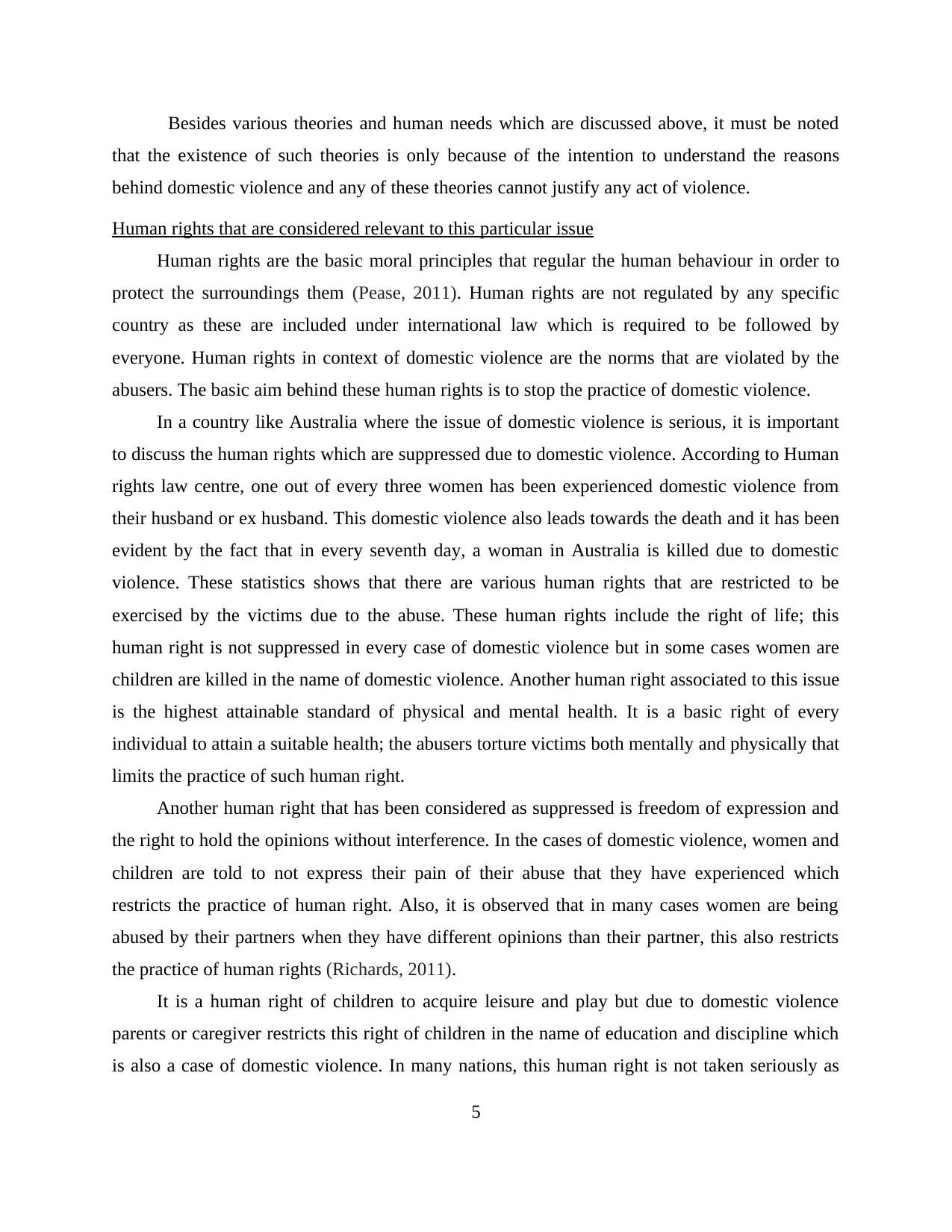
Besides various theories and human needs which are discussed above, it must be noted
that the existence of such theories is only because of the intention to understand the reasons
behind domestic violence and any of these theories cannot justify any act of violence.
Human rights that are considered relevant to this particular issue
Human rights are the basic moral principles that regular the human behaviour in order to
protect the surroundings them (Pease, 2011). Human rights are not regulated by any specific
country as these are included under international law which is required to be followed by
everyone. Human rights in context of domestic violence are the norms that are violated by the
abusers. The basic aim behind these human rights is to stop the practice of domestic violence.
In a country like Australia where the issue of domestic violence is serious, it is important
to discuss the human rights which are suppressed due to domestic violence. According to Human
rights law centre, one out of every three women has been experienced domestic violence from
their husband or ex husband. This domestic violence also leads towards the death and it has been
evident by the fact that in every seventh day, a woman in Australia is killed due to domestic
violence. These statistics shows that there are various human rights that are restricted to be
exercised by the victims due to the abuse. These human rights include the right of life; this
human right is not suppressed in every case of domestic violence but in some cases women are
children are killed in the name of domestic violence. Another human right associated to this issue
is the highest attainable standard of physical and mental health. It is a basic right of every
individual to attain a suitable health; the abusers torture victims both mentally and physically that
limits the practice of such human right.
Another human right that has been considered as suppressed is freedom of expression and
the right to hold the opinions without interference. In the cases of domestic violence, women and
children are told to not express their pain of their abuse that they have experienced which
restricts the practice of human right. Also, it is observed that in many cases women are being
abused by their partners when they have different opinions than their partner, this also restricts
the practice of human rights (Richards, 2011).
It is a human right of children to acquire leisure and play but due to domestic violence
parents or caregiver restricts this right of children in the name of education and discipline which
is also a case of domestic violence. In many nations, this human right is not taken seriously as
5
that the existence of such theories is only because of the intention to understand the reasons
behind domestic violence and any of these theories cannot justify any act of violence.
Human rights that are considered relevant to this particular issue
Human rights are the basic moral principles that regular the human behaviour in order to
protect the surroundings them (Pease, 2011). Human rights are not regulated by any specific
country as these are included under international law which is required to be followed by
everyone. Human rights in context of domestic violence are the norms that are violated by the
abusers. The basic aim behind these human rights is to stop the practice of domestic violence.
In a country like Australia where the issue of domestic violence is serious, it is important
to discuss the human rights which are suppressed due to domestic violence. According to Human
rights law centre, one out of every three women has been experienced domestic violence from
their husband or ex husband. This domestic violence also leads towards the death and it has been
evident by the fact that in every seventh day, a woman in Australia is killed due to domestic
violence. These statistics shows that there are various human rights that are restricted to be
exercised by the victims due to the abuse. These human rights include the right of life; this
human right is not suppressed in every case of domestic violence but in some cases women are
children are killed in the name of domestic violence. Another human right associated to this issue
is the highest attainable standard of physical and mental health. It is a basic right of every
individual to attain a suitable health; the abusers torture victims both mentally and physically that
limits the practice of such human right.
Another human right that has been considered as suppressed is freedom of expression and
the right to hold the opinions without interference. In the cases of domestic violence, women and
children are told to not express their pain of their abuse that they have experienced which
restricts the practice of human right. Also, it is observed that in many cases women are being
abused by their partners when they have different opinions than their partner, this also restricts
the practice of human rights (Richards, 2011).
It is a human right of children to acquire leisure and play but due to domestic violence
parents or caregiver restricts this right of children in the name of education and discipline which
is also a case of domestic violence. In many nations, this human right is not taken seriously as
5
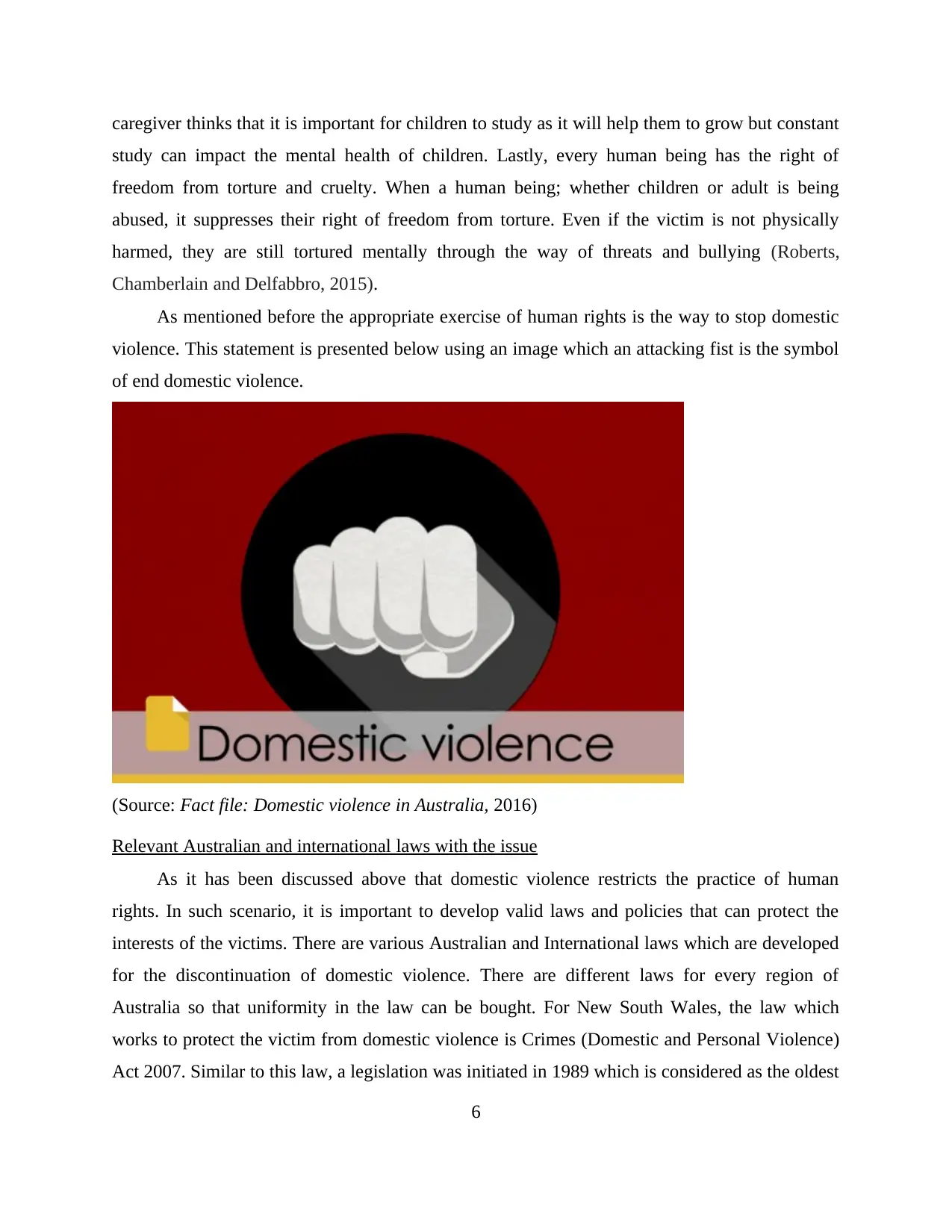
caregiver thinks that it is important for children to study as it will help them to grow but constant
study can impact the mental health of children. Lastly, every human being has the right of
freedom from torture and cruelty. When a human being; whether children or adult is being
abused, it suppresses their right of freedom from torture. Even if the victim is not physically
harmed, they are still tortured mentally through the way of threats and bullying (Roberts,
Chamberlain and Delfabbro, 2015).
As mentioned before the appropriate exercise of human rights is the way to stop domestic
violence. This statement is presented below using an image which an attacking fist is the symbol
of end domestic violence.
(Source: Fact file: Domestic violence in Australia, 2016)
Relevant Australian and international laws with the issue
As it has been discussed above that domestic violence restricts the practice of human
rights. In such scenario, it is important to develop valid laws and policies that can protect the
interests of the victims. There are various Australian and International laws which are developed
for the discontinuation of domestic violence. There are different laws for every region of
Australia so that uniformity in the law can be bought. For New South Wales, the law which
works to protect the victim from domestic violence is Crimes (Domestic and Personal Violence)
Act 2007. Similar to this law, a legislation was initiated in 1989 which is considered as the oldest
6
study can impact the mental health of children. Lastly, every human being has the right of
freedom from torture and cruelty. When a human being; whether children or adult is being
abused, it suppresses their right of freedom from torture. Even if the victim is not physically
harmed, they are still tortured mentally through the way of threats and bullying (Roberts,
Chamberlain and Delfabbro, 2015).
As mentioned before the appropriate exercise of human rights is the way to stop domestic
violence. This statement is presented below using an image which an attacking fist is the symbol
of end domestic violence.
(Source: Fact file: Domestic violence in Australia, 2016)
Relevant Australian and international laws with the issue
As it has been discussed above that domestic violence restricts the practice of human
rights. In such scenario, it is important to develop valid laws and policies that can protect the
interests of the victims. There are various Australian and International laws which are developed
for the discontinuation of domestic violence. There are different laws for every region of
Australia so that uniformity in the law can be bought. For New South Wales, the law which
works to protect the victim from domestic violence is Crimes (Domestic and Personal Violence)
Act 2007. Similar to this law, a legislation was initiated in 1989 which is considered as the oldest
6
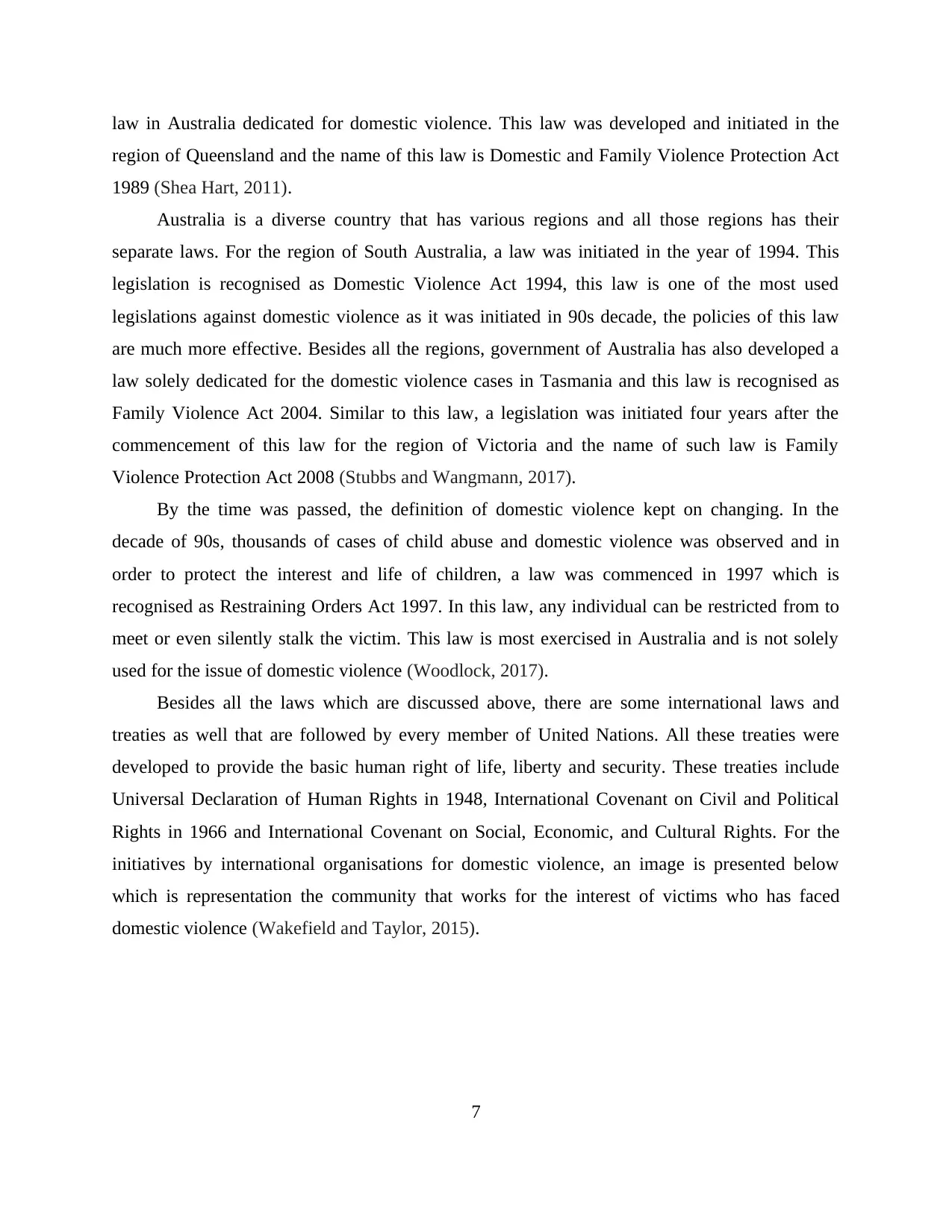
law in Australia dedicated for domestic violence. This law was developed and initiated in the
region of Queensland and the name of this law is Domestic and Family Violence Protection Act
1989 (Shea Hart, 2011).
Australia is a diverse country that has various regions and all those regions has their
separate laws. For the region of South Australia, a law was initiated in the year of 1994. This
legislation is recognised as Domestic Violence Act 1994, this law is one of the most used
legislations against domestic violence as it was initiated in 90s decade, the policies of this law
are much more effective. Besides all the regions, government of Australia has also developed a
law solely dedicated for the domestic violence cases in Tasmania and this law is recognised as
Family Violence Act 2004. Similar to this law, a legislation was initiated four years after the
commencement of this law for the region of Victoria and the name of such law is Family
Violence Protection Act 2008 (Stubbs and Wangmann, 2017).
By the time was passed, the definition of domestic violence kept on changing. In the
decade of 90s, thousands of cases of child abuse and domestic violence was observed and in
order to protect the interest and life of children, a law was commenced in 1997 which is
recognised as Restraining Orders Act 1997. In this law, any individual can be restricted from to
meet or even silently stalk the victim. This law is most exercised in Australia and is not solely
used for the issue of domestic violence (Woodlock, 2017).
Besides all the laws which are discussed above, there are some international laws and
treaties as well that are followed by every member of United Nations. All these treaties were
developed to provide the basic human right of life, liberty and security. These treaties include
Universal Declaration of Human Rights in 1948, International Covenant on Civil and Political
Rights in 1966 and International Covenant on Social, Economic, and Cultural Rights. For the
initiatives by international organisations for domestic violence, an image is presented below
which is representation the community that works for the interest of victims who has faced
domestic violence (Wakefield and Taylor, 2015).
7
region of Queensland and the name of this law is Domestic and Family Violence Protection Act
1989 (Shea Hart, 2011).
Australia is a diverse country that has various regions and all those regions has their
separate laws. For the region of South Australia, a law was initiated in the year of 1994. This
legislation is recognised as Domestic Violence Act 1994, this law is one of the most used
legislations against domestic violence as it was initiated in 90s decade, the policies of this law
are much more effective. Besides all the regions, government of Australia has also developed a
law solely dedicated for the domestic violence cases in Tasmania and this law is recognised as
Family Violence Act 2004. Similar to this law, a legislation was initiated four years after the
commencement of this law for the region of Victoria and the name of such law is Family
Violence Protection Act 2008 (Stubbs and Wangmann, 2017).
By the time was passed, the definition of domestic violence kept on changing. In the
decade of 90s, thousands of cases of child abuse and domestic violence was observed and in
order to protect the interest and life of children, a law was commenced in 1997 which is
recognised as Restraining Orders Act 1997. In this law, any individual can be restricted from to
meet or even silently stalk the victim. This law is most exercised in Australia and is not solely
used for the issue of domestic violence (Woodlock, 2017).
Besides all the laws which are discussed above, there are some international laws and
treaties as well that are followed by every member of United Nations. All these treaties were
developed to provide the basic human right of life, liberty and security. These treaties include
Universal Declaration of Human Rights in 1948, International Covenant on Civil and Political
Rights in 1966 and International Covenant on Social, Economic, and Cultural Rights. For the
initiatives by international organisations for domestic violence, an image is presented below
which is representation the community that works for the interest of victims who has faced
domestic violence (Wakefield and Taylor, 2015).
7
Secure Best Marks with AI Grader
Need help grading? Try our AI Grader for instant feedback on your assignments.
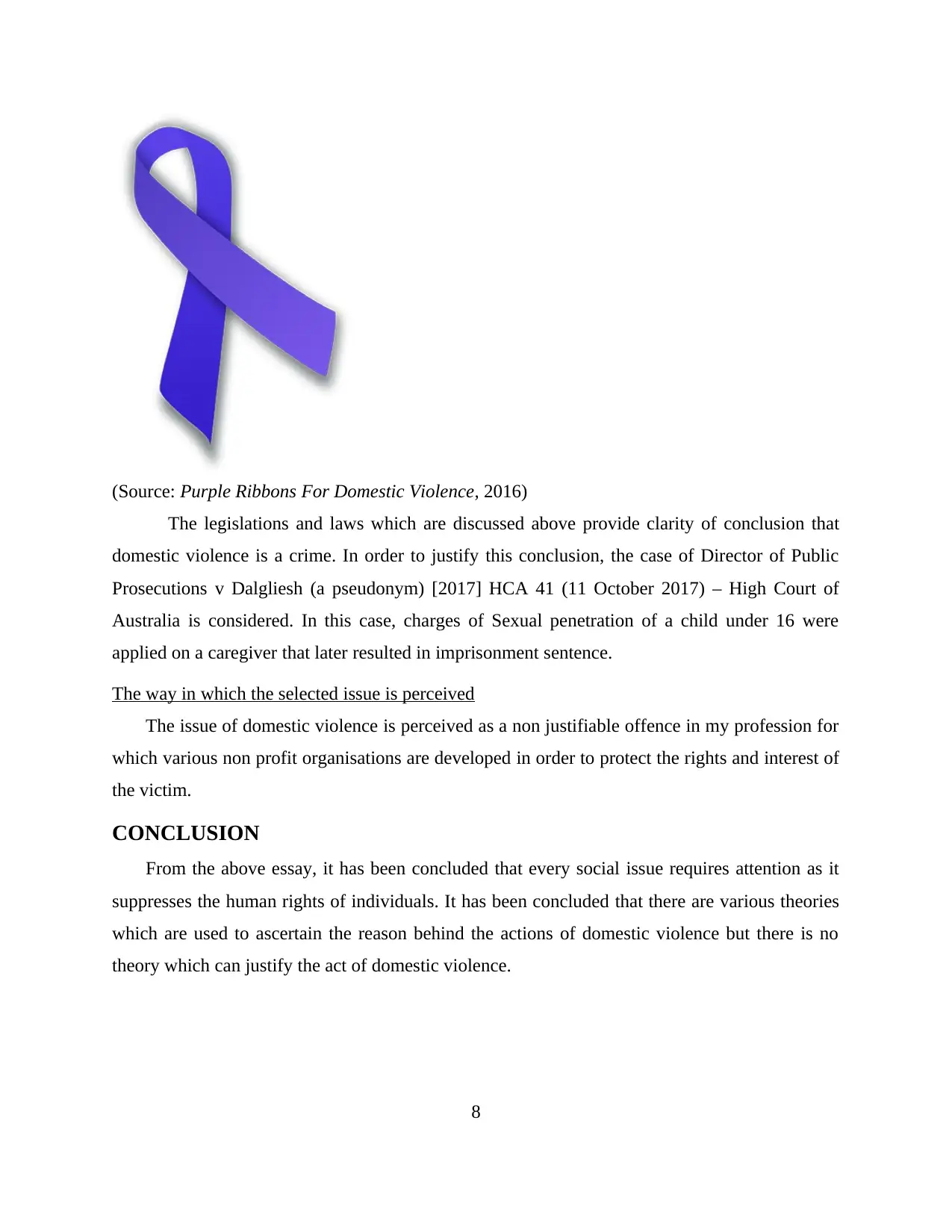
(Source: Purple Ribbons For Domestic Violence, 2016)
The legislations and laws which are discussed above provide clarity of conclusion that
domestic violence is a crime. In order to justify this conclusion, the case of Director of Public
Prosecutions v Dalgliesh (a pseudonym) [2017] HCA 41 (11 October 2017) – High Court of
Australia is considered. In this case, charges of Sexual penetration of a child under 16 were
applied on a caregiver that later resulted in imprisonment sentence.
The way in which the selected issue is perceived
The issue of domestic violence is perceived as a non justifiable offence in my profession for
which various non profit organisations are developed in order to protect the rights and interest of
the victim.
CONCLUSION
From the above essay, it has been concluded that every social issue requires attention as it
suppresses the human rights of individuals. It has been concluded that there are various theories
which are used to ascertain the reason behind the actions of domestic violence but there is no
theory which can justify the act of domestic violence.
8
The legislations and laws which are discussed above provide clarity of conclusion that
domestic violence is a crime. In order to justify this conclusion, the case of Director of Public
Prosecutions v Dalgliesh (a pseudonym) [2017] HCA 41 (11 October 2017) – High Court of
Australia is considered. In this case, charges of Sexual penetration of a child under 16 were
applied on a caregiver that later resulted in imprisonment sentence.
The way in which the selected issue is perceived
The issue of domestic violence is perceived as a non justifiable offence in my profession for
which various non profit organisations are developed in order to protect the rights and interest of
the victim.
CONCLUSION
From the above essay, it has been concluded that every social issue requires attention as it
suppresses the human rights of individuals. It has been concluded that there are various theories
which are used to ascertain the reason behind the actions of domestic violence but there is no
theory which can justify the act of domestic violence.
8
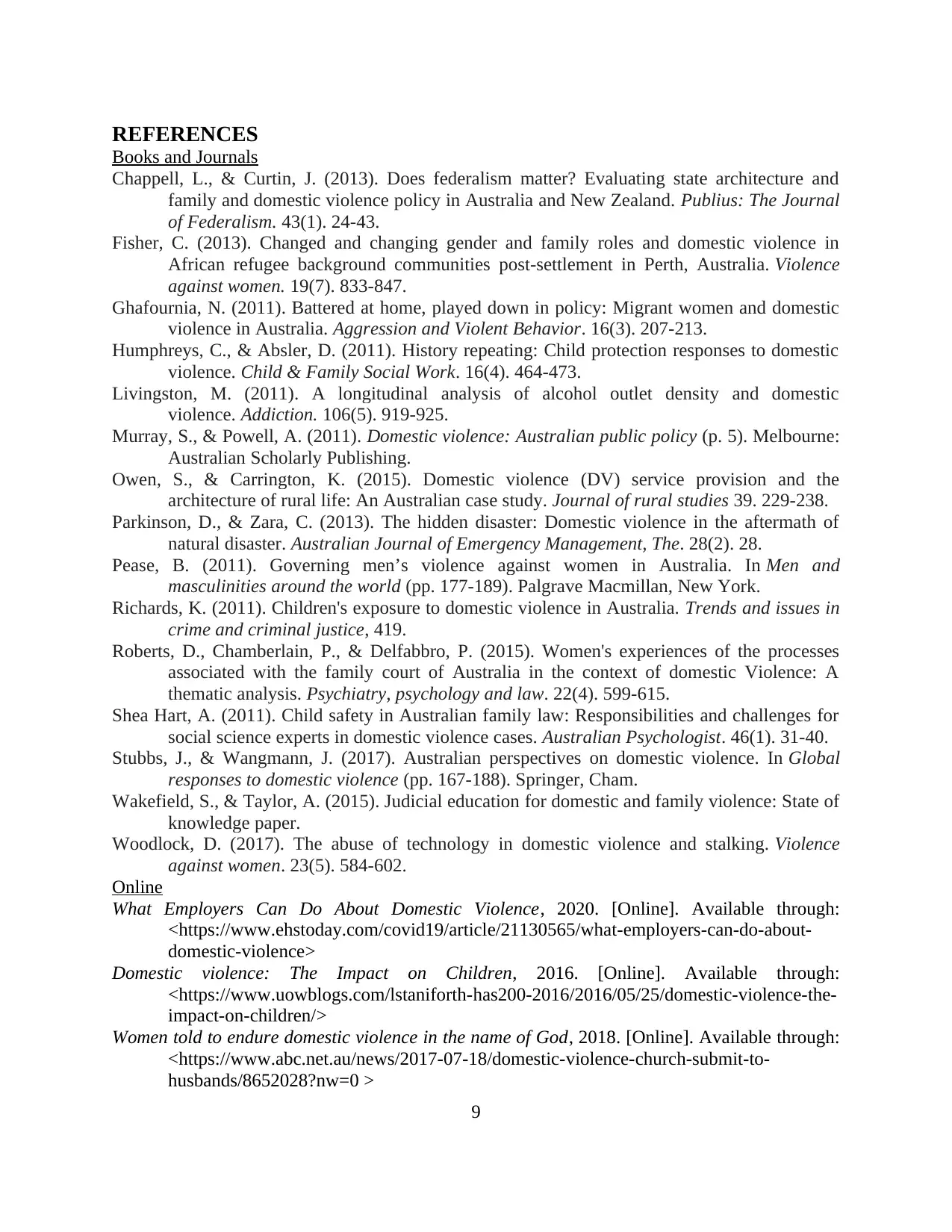
REFERENCES
Books and Journals
Chappell, L., & Curtin, J. (2013). Does federalism matter? Evaluating state architecture and
family and domestic violence policy in Australia and New Zealand. Publius: The Journal
of Federalism. 43(1). 24-43.
Fisher, C. (2013). Changed and changing gender and family roles and domestic violence in
African refugee background communities post-settlement in Perth, Australia. Violence
against women. 19(7). 833-847.
Ghafournia, N. (2011). Battered at home, played down in policy: Migrant women and domestic
violence in Australia. Aggression and Violent Behavior. 16(3). 207-213.
Humphreys, C., & Absler, D. (2011). History repeating: Child protection responses to domestic
violence. Child & Family Social Work. 16(4). 464-473.
Livingston, M. (2011). A longitudinal analysis of alcohol outlet density and domestic
violence. Addiction. 106(5). 919-925.
Murray, S., & Powell, A. (2011). Domestic violence: Australian public policy (p. 5). Melbourne:
Australian Scholarly Publishing.
Owen, S., & Carrington, K. (2015). Domestic violence (DV) service provision and the
architecture of rural life: An Australian case study. Journal of rural studies 39. 229-238.
Parkinson, D., & Zara, C. (2013). The hidden disaster: Domestic violence in the aftermath of
natural disaster. Australian Journal of Emergency Management, The. 28(2). 28.
Pease, B. (2011). Governing men’s violence against women in Australia. In Men and
masculinities around the world (pp. 177-189). Palgrave Macmillan, New York.
Richards, K. (2011). Children's exposure to domestic violence in Australia. Trends and issues in
crime and criminal justice, 419.
Roberts, D., Chamberlain, P., & Delfabbro, P. (2015). Women's experiences of the processes
associated with the family court of Australia in the context of domestic Violence: A
thematic analysis. Psychiatry, psychology and law. 22(4). 599-615.
Shea Hart, A. (2011). Child safety in Australian family law: Responsibilities and challenges for
social science experts in domestic violence cases. Australian Psychologist. 46(1). 31-40.
Stubbs, J., & Wangmann, J. (2017). Australian perspectives on domestic violence. In Global
responses to domestic violence (pp. 167-188). Springer, Cham.
Wakefield, S., & Taylor, A. (2015). Judicial education for domestic and family violence: State of
knowledge paper.
Woodlock, D. (2017). The abuse of technology in domestic violence and stalking. Violence
against women. 23(5). 584-602.
Online
What Employers Can Do About Domestic Violence, 2020. [Online]. Available through:
<https://www.ehstoday.com/covid19/article/21130565/what-employers-can-do-about-
domestic-violence>
Domestic violence: The Impact on Children, 2016. [Online]. Available through:
<https://www.uowblogs.com/lstaniforth-has200-2016/2016/05/25/domestic-violence-the-
impact-on-children/>
Women told to endure domestic violence in the name of God, 2018. [Online]. Available through:
<https://www.abc.net.au/news/2017-07-18/domestic-violence-church-submit-to-
husbands/8652028?nw=0 >
9
Books and Journals
Chappell, L., & Curtin, J. (2013). Does federalism matter? Evaluating state architecture and
family and domestic violence policy in Australia and New Zealand. Publius: The Journal
of Federalism. 43(1). 24-43.
Fisher, C. (2013). Changed and changing gender and family roles and domestic violence in
African refugee background communities post-settlement in Perth, Australia. Violence
against women. 19(7). 833-847.
Ghafournia, N. (2011). Battered at home, played down in policy: Migrant women and domestic
violence in Australia. Aggression and Violent Behavior. 16(3). 207-213.
Humphreys, C., & Absler, D. (2011). History repeating: Child protection responses to domestic
violence. Child & Family Social Work. 16(4). 464-473.
Livingston, M. (2011). A longitudinal analysis of alcohol outlet density and domestic
violence. Addiction. 106(5). 919-925.
Murray, S., & Powell, A. (2011). Domestic violence: Australian public policy (p. 5). Melbourne:
Australian Scholarly Publishing.
Owen, S., & Carrington, K. (2015). Domestic violence (DV) service provision and the
architecture of rural life: An Australian case study. Journal of rural studies 39. 229-238.
Parkinson, D., & Zara, C. (2013). The hidden disaster: Domestic violence in the aftermath of
natural disaster. Australian Journal of Emergency Management, The. 28(2). 28.
Pease, B. (2011). Governing men’s violence against women in Australia. In Men and
masculinities around the world (pp. 177-189). Palgrave Macmillan, New York.
Richards, K. (2011). Children's exposure to domestic violence in Australia. Trends and issues in
crime and criminal justice, 419.
Roberts, D., Chamberlain, P., & Delfabbro, P. (2015). Women's experiences of the processes
associated with the family court of Australia in the context of domestic Violence: A
thematic analysis. Psychiatry, psychology and law. 22(4). 599-615.
Shea Hart, A. (2011). Child safety in Australian family law: Responsibilities and challenges for
social science experts in domestic violence cases. Australian Psychologist. 46(1). 31-40.
Stubbs, J., & Wangmann, J. (2017). Australian perspectives on domestic violence. In Global
responses to domestic violence (pp. 167-188). Springer, Cham.
Wakefield, S., & Taylor, A. (2015). Judicial education for domestic and family violence: State of
knowledge paper.
Woodlock, D. (2017). The abuse of technology in domestic violence and stalking. Violence
against women. 23(5). 584-602.
Online
What Employers Can Do About Domestic Violence, 2020. [Online]. Available through:
<https://www.ehstoday.com/covid19/article/21130565/what-employers-can-do-about-
domestic-violence>
Domestic violence: The Impact on Children, 2016. [Online]. Available through:
<https://www.uowblogs.com/lstaniforth-has200-2016/2016/05/25/domestic-violence-the-
impact-on-children/>
Women told to endure domestic violence in the name of God, 2018. [Online]. Available through:
<https://www.abc.net.au/news/2017-07-18/domestic-violence-church-submit-to-
husbands/8652028?nw=0 >
9
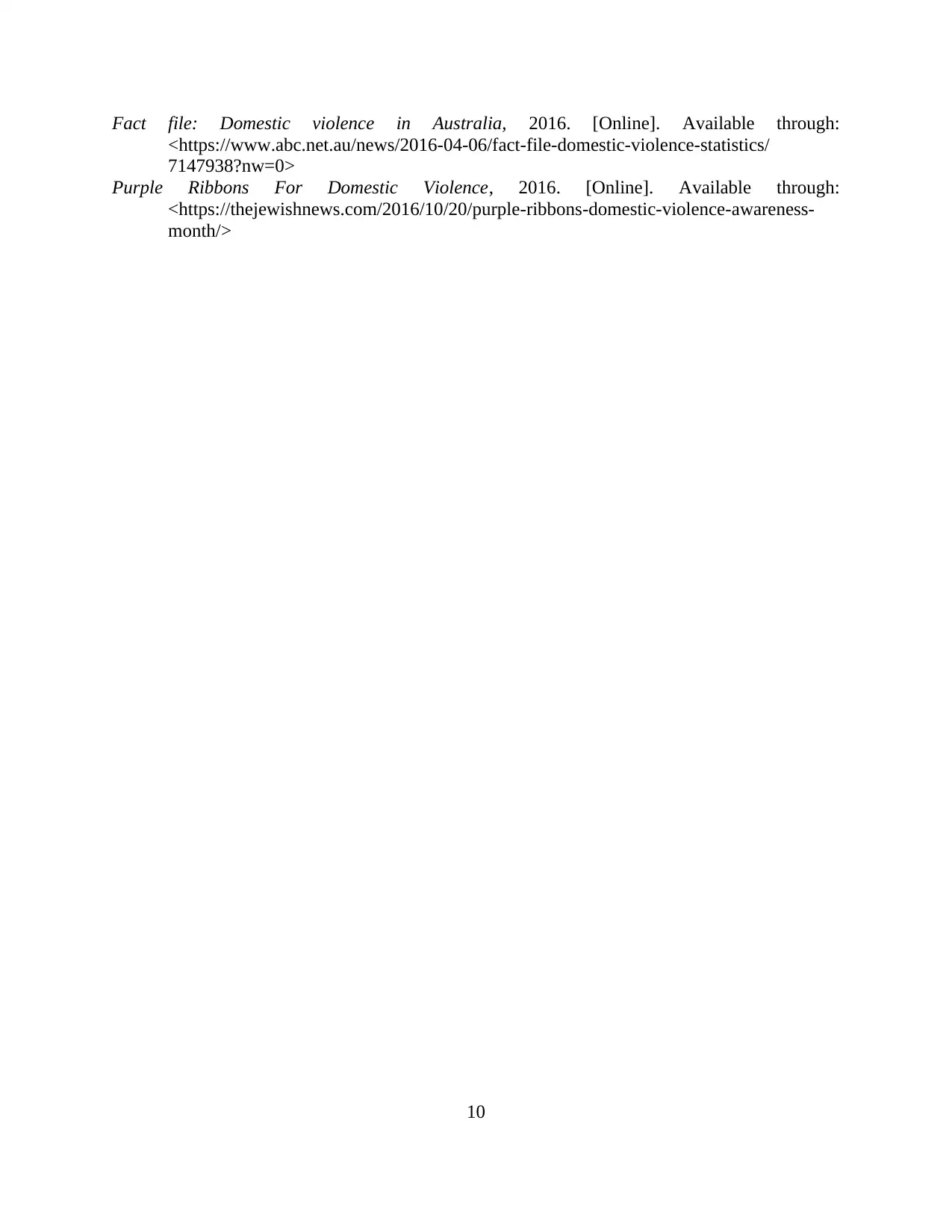
Fact file: Domestic violence in Australia, 2016. [Online]. Available through:
<https://www.abc.net.au/news/2016-04-06/fact-file-domestic-violence-statistics/
7147938?nw=0>
Purple Ribbons For Domestic Violence, 2016. [Online]. Available through:
<https://thejewishnews.com/2016/10/20/purple-ribbons-domestic-violence-awareness-
month/>
10
<https://www.abc.net.au/news/2016-04-06/fact-file-domestic-violence-statistics/
7147938?nw=0>
Purple Ribbons For Domestic Violence, 2016. [Online]. Available through:
<https://thejewishnews.com/2016/10/20/purple-ribbons-domestic-violence-awareness-
month/>
10
1 out of 13
Related Documents
Your All-in-One AI-Powered Toolkit for Academic Success.
+13062052269
info@desklib.com
Available 24*7 on WhatsApp / Email
![[object Object]](/_next/static/media/star-bottom.7253800d.svg)
Unlock your academic potential
© 2024 | Zucol Services PVT LTD | All rights reserved.





